Detailed Analysis of a Gene Mapping Experiment in Biology
VerifiedAdded on 2020/03/04
|13
|2597
|65
Report
AI Summary
This report details a gene mapping experiment, exploring the relationship between an organism's phenotype and genotype using the fruit fly (Drosophila melanogaster). The study covers key genetic concepts such as monohybrid and dihybrid inheritance, test crosses, lethal genes, epistasis, sex linkage, and recombination. Through various experiments, including crosses involving eye color, body color, wing size, and wing vein mutations, the report illustrates Mendelian inheritance patterns and the application of statistical methods like the chi-square test. The findings highlight the importance of gene mapping in understanding genetic traits and its applications in medicine, agriculture, and forensics. The report concludes with a discussion on the significance of genetic mapping in advancing scientific understanding and its impact on various fields, emphasizing the use of different methods such as Mendel's cross, Punnett squares and chi-square tests, and the results obtained from each experiment. The report demonstrates the importance of genetic mapping in understanding genetic traits and its applications in medicine, agriculture, and forensics.

Students name
Institution/affiliation
Date
Gene mapping
Institution/affiliation
Date
Gene mapping
Paraphrase This Document
Need a fresh take? Get an instant paraphrase of this document with our AI Paraphraser
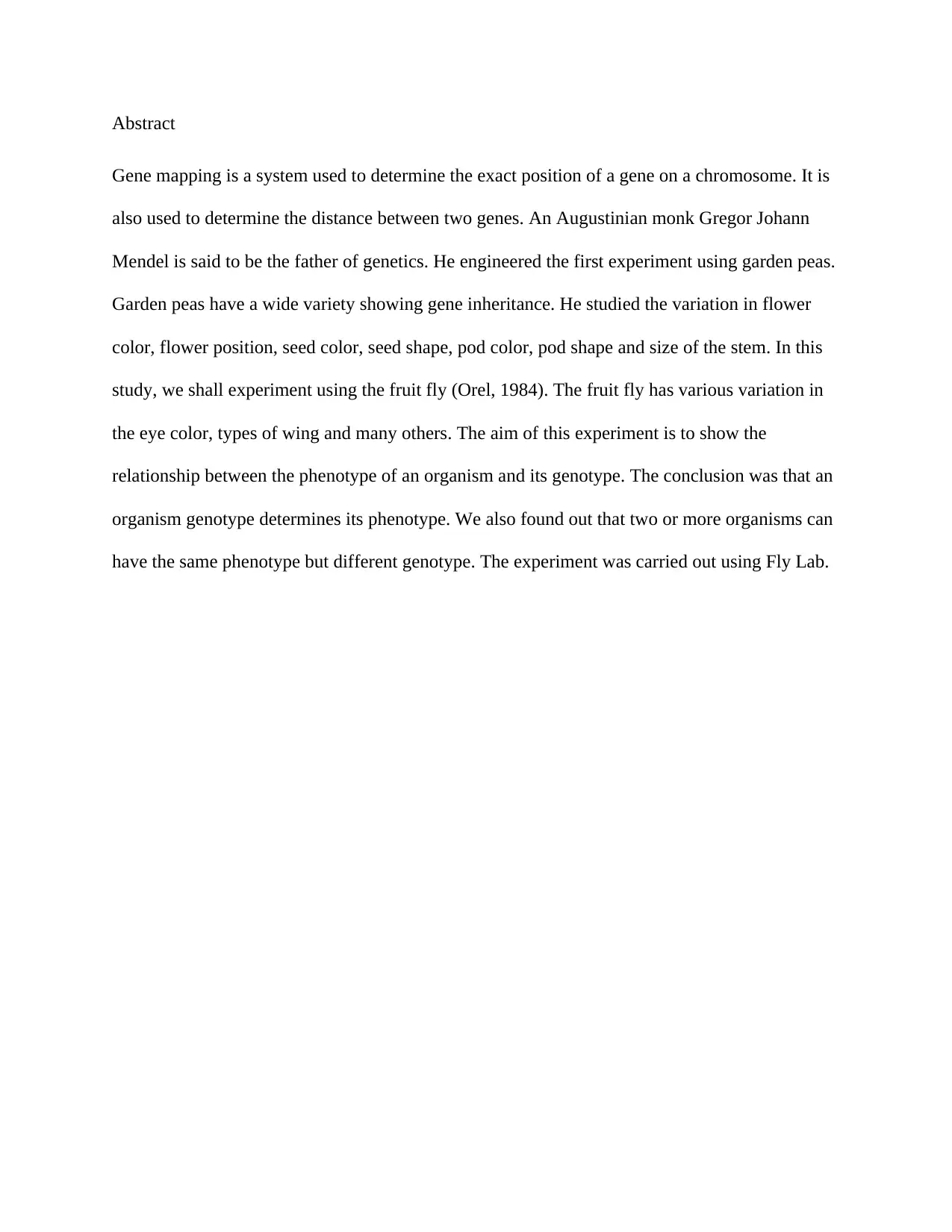
Abstract
Gene mapping is a system used to determine the exact position of a gene on a chromosome. It is
also used to determine the distance between two genes. An Augustinian monk Gregor Johann
Mendel is said to be the father of genetics. He engineered the first experiment using garden peas.
Garden peas have a wide variety showing gene inheritance. He studied the variation in flower
color, flower position, seed color, seed shape, pod color, pod shape and size of the stem. In this
study, we shall experiment using the fruit fly (Orel, 1984). The fruit fly has various variation in
the eye color, types of wing and many others. The aim of this experiment is to show the
relationship between the phenotype of an organism and its genotype. The conclusion was that an
organism genotype determines its phenotype. We also found out that two or more organisms can
have the same phenotype but different genotype. The experiment was carried out using Fly Lab.
Gene mapping is a system used to determine the exact position of a gene on a chromosome. It is
also used to determine the distance between two genes. An Augustinian monk Gregor Johann
Mendel is said to be the father of genetics. He engineered the first experiment using garden peas.
Garden peas have a wide variety showing gene inheritance. He studied the variation in flower
color, flower position, seed color, seed shape, pod color, pod shape and size of the stem. In this
study, we shall experiment using the fruit fly (Orel, 1984). The fruit fly has various variation in
the eye color, types of wing and many others. The aim of this experiment is to show the
relationship between the phenotype of an organism and its genotype. The conclusion was that an
organism genotype determines its phenotype. We also found out that two or more organisms can
have the same phenotype but different genotype. The experiment was carried out using Fly Lab.
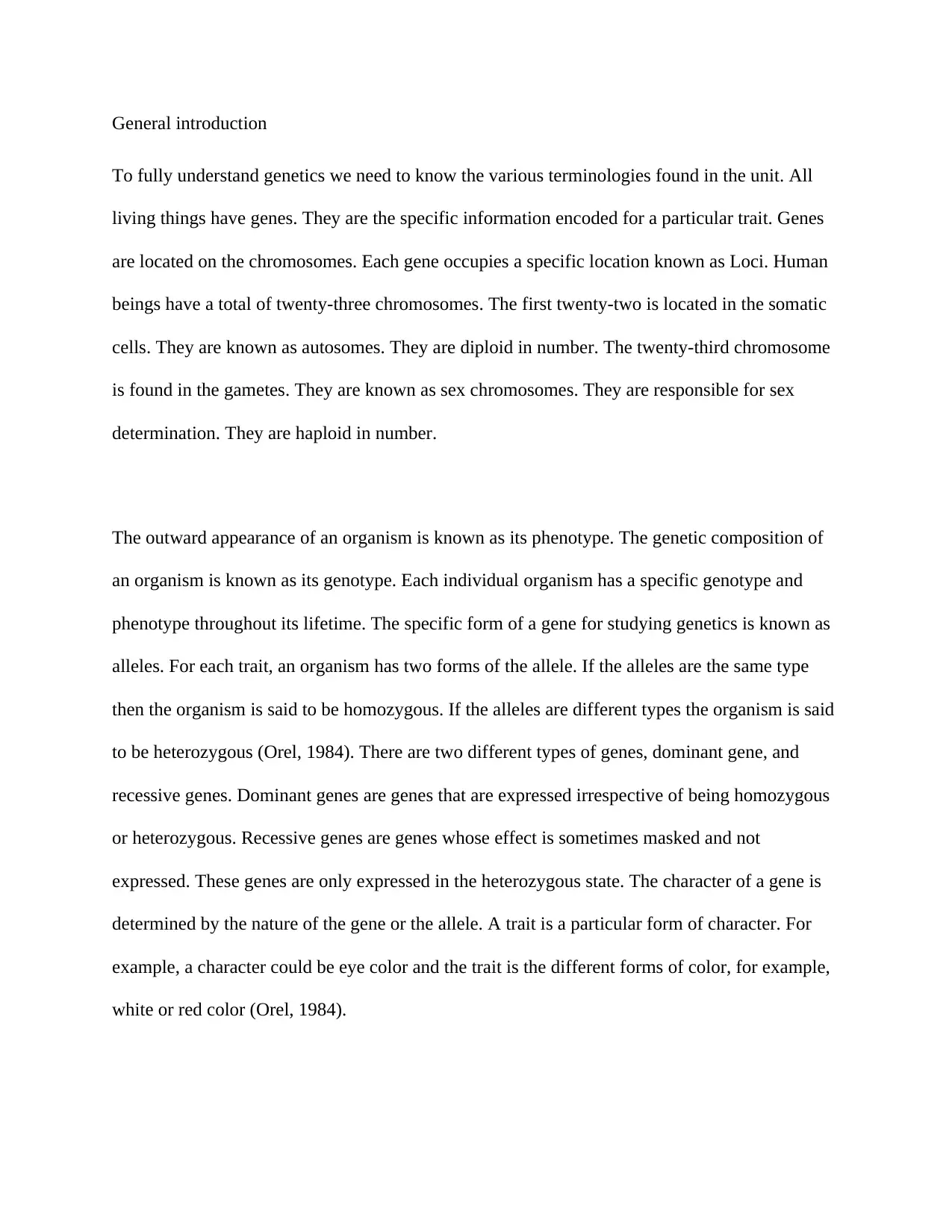
General introduction
To fully understand genetics we need to know the various terminologies found in the unit. All
living things have genes. They are the specific information encoded for a particular trait. Genes
are located on the chromosomes. Each gene occupies a specific location known as Loci. Human
beings have a total of twenty-three chromosomes. The first twenty-two is located in the somatic
cells. They are known as autosomes. They are diploid in number. The twenty-third chromosome
is found in the gametes. They are known as sex chromosomes. They are responsible for sex
determination. They are haploid in number.
The outward appearance of an organism is known as its phenotype. The genetic composition of
an organism is known as its genotype. Each individual organism has a specific genotype and
phenotype throughout its lifetime. The specific form of a gene for studying genetics is known as
alleles. For each trait, an organism has two forms of the allele. If the alleles are the same type
then the organism is said to be homozygous. If the alleles are different types the organism is said
to be heterozygous (Orel, 1984). There are two different types of genes, dominant gene, and
recessive genes. Dominant genes are genes that are expressed irrespective of being homozygous
or heterozygous. Recessive genes are genes whose effect is sometimes masked and not
expressed. These genes are only expressed in the heterozygous state. The character of a gene is
determined by the nature of the gene or the allele. A trait is a particular form of character. For
example, a character could be eye color and the trait is the different forms of color, for example,
white or red color (Orel, 1984).
To fully understand genetics we need to know the various terminologies found in the unit. All
living things have genes. They are the specific information encoded for a particular trait. Genes
are located on the chromosomes. Each gene occupies a specific location known as Loci. Human
beings have a total of twenty-three chromosomes. The first twenty-two is located in the somatic
cells. They are known as autosomes. They are diploid in number. The twenty-third chromosome
is found in the gametes. They are known as sex chromosomes. They are responsible for sex
determination. They are haploid in number.
The outward appearance of an organism is known as its phenotype. The genetic composition of
an organism is known as its genotype. Each individual organism has a specific genotype and
phenotype throughout its lifetime. The specific form of a gene for studying genetics is known as
alleles. For each trait, an organism has two forms of the allele. If the alleles are the same type
then the organism is said to be homozygous. If the alleles are different types the organism is said
to be heterozygous (Orel, 1984). There are two different types of genes, dominant gene, and
recessive genes. Dominant genes are genes that are expressed irrespective of being homozygous
or heterozygous. Recessive genes are genes whose effect is sometimes masked and not
expressed. These genes are only expressed in the heterozygous state. The character of a gene is
determined by the nature of the gene or the allele. A trait is a particular form of character. For
example, a character could be eye color and the trait is the different forms of color, for example,
white or red color (Orel, 1984).
⊘ This is a preview!⊘
Do you want full access?
Subscribe today to unlock all pages.

Trusted by 1+ million students worldwide
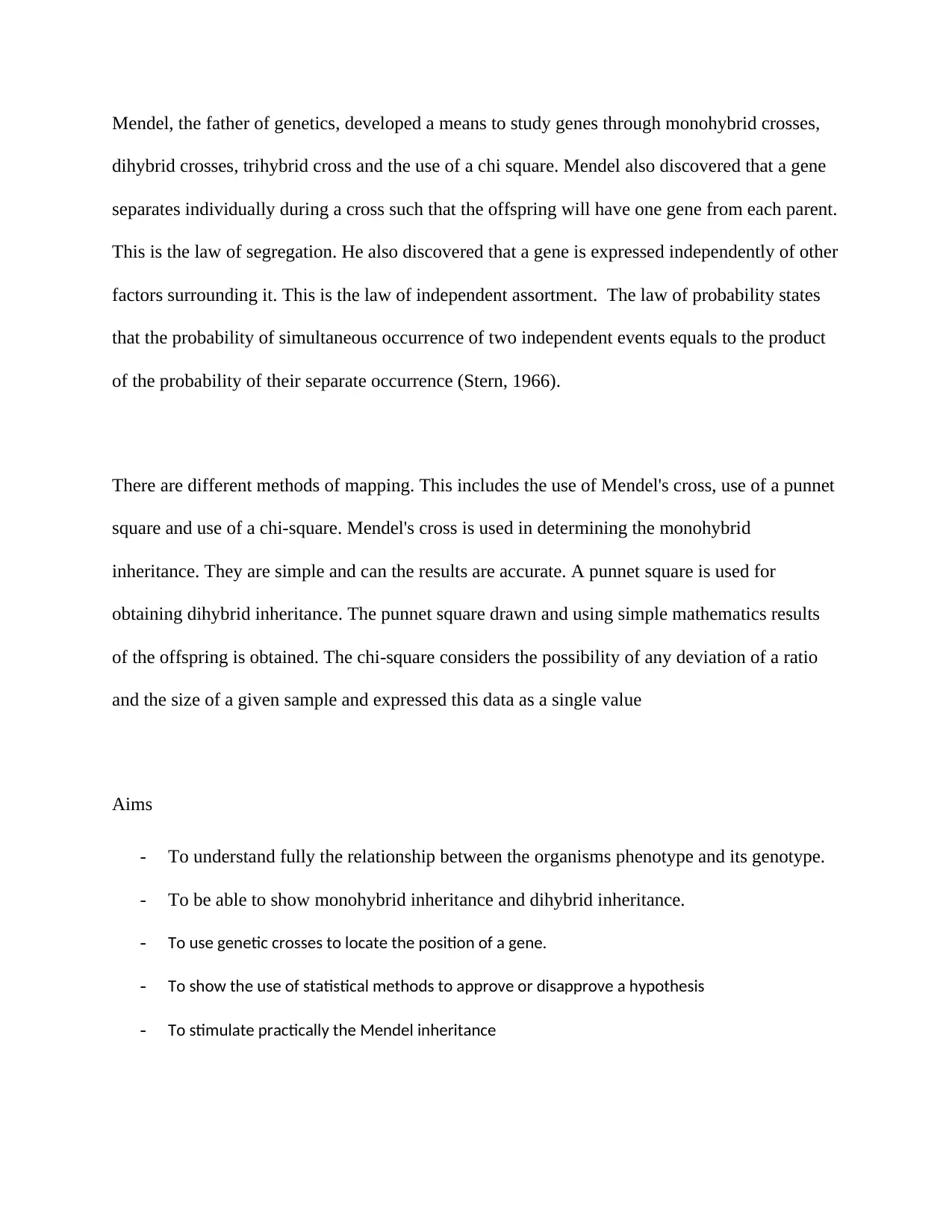
Mendel, the father of genetics, developed a means to study genes through monohybrid crosses,
dihybrid crosses, trihybrid cross and the use of a chi square. Mendel also discovered that a gene
separates individually during a cross such that the offspring will have one gene from each parent.
This is the law of segregation. He also discovered that a gene is expressed independently of other
factors surrounding it. This is the law of independent assortment. The law of probability states
that the probability of simultaneous occurrence of two independent events equals to the product
of the probability of their separate occurrence (Stern, 1966).
There are different methods of mapping. This includes the use of Mendel's cross, use of a punnet
square and use of a chi-square. Mendel's cross is used in determining the monohybrid
inheritance. They are simple and can the results are accurate. A punnet square is used for
obtaining dihybrid inheritance. The punnet square drawn and using simple mathematics results
of the offspring is obtained. The chi-square considers the possibility of any deviation of a ratio
and the size of a given sample and expressed this data as a single value
Aims
- To understand fully the relationship between the organisms phenotype and its genotype.
- To be able to show monohybrid inheritance and dihybrid inheritance.
- To use genetic crosses to locate the position of a gene.
- To show the use of statistical methods to approve or disapprove a hypothesis
- To stimulate practically the Mendel inheritance
dihybrid crosses, trihybrid cross and the use of a chi square. Mendel also discovered that a gene
separates individually during a cross such that the offspring will have one gene from each parent.
This is the law of segregation. He also discovered that a gene is expressed independently of other
factors surrounding it. This is the law of independent assortment. The law of probability states
that the probability of simultaneous occurrence of two independent events equals to the product
of the probability of their separate occurrence (Stern, 1966).
There are different methods of mapping. This includes the use of Mendel's cross, use of a punnet
square and use of a chi-square. Mendel's cross is used in determining the monohybrid
inheritance. They are simple and can the results are accurate. A punnet square is used for
obtaining dihybrid inheritance. The punnet square drawn and using simple mathematics results
of the offspring is obtained. The chi-square considers the possibility of any deviation of a ratio
and the size of a given sample and expressed this data as a single value
Aims
- To understand fully the relationship between the organisms phenotype and its genotype.
- To be able to show monohybrid inheritance and dihybrid inheritance.
- To use genetic crosses to locate the position of a gene.
- To show the use of statistical methods to approve or disapprove a hypothesis
- To stimulate practically the Mendel inheritance
Paraphrase This Document
Need a fresh take? Get an instant paraphrase of this document with our AI Paraphraser
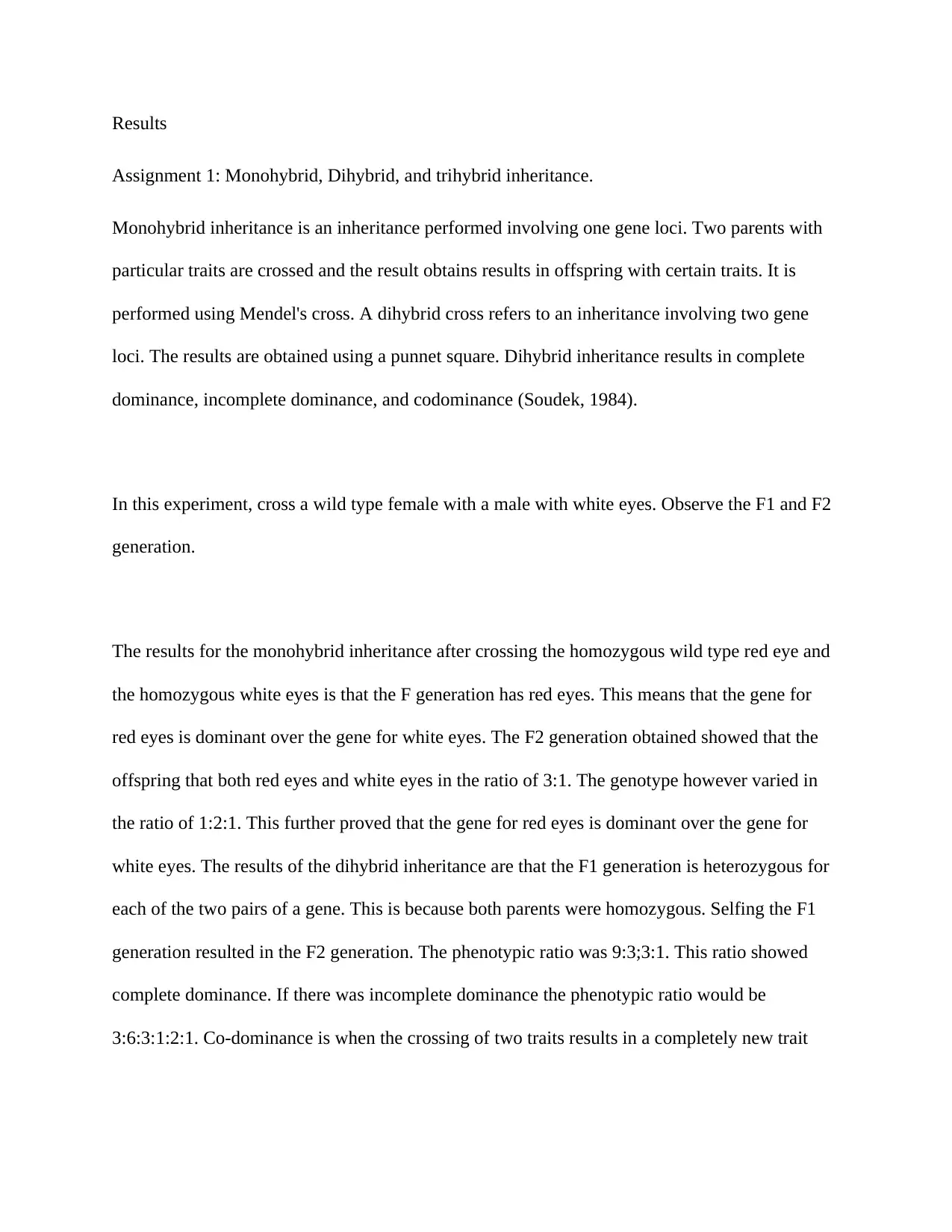
Results
Assignment 1: Monohybrid, Dihybrid, and trihybrid inheritance.
Monohybrid inheritance is an inheritance performed involving one gene loci. Two parents with
particular traits are crossed and the result obtains results in offspring with certain traits. It is
performed using Mendel's cross. A dihybrid cross refers to an inheritance involving two gene
loci. The results are obtained using a punnet square. Dihybrid inheritance results in complete
dominance, incomplete dominance, and codominance (Soudek, 1984).
In this experiment, cross a wild type female with a male with white eyes. Observe the F1 and F2
generation.
The results for the monohybrid inheritance after crossing the homozygous wild type red eye and
the homozygous white eyes is that the F generation has red eyes. This means that the gene for
red eyes is dominant over the gene for white eyes. The F2 generation obtained showed that the
offspring that both red eyes and white eyes in the ratio of 3:1. The genotype however varied in
the ratio of 1:2:1. This further proved that the gene for red eyes is dominant over the gene for
white eyes. The results of the dihybrid inheritance are that the F1 generation is heterozygous for
each of the two pairs of a gene. This is because both parents were homozygous. Selfing the F1
generation resulted in the F2 generation. The phenotypic ratio was 9:3;3:1. This ratio showed
complete dominance. If there was incomplete dominance the phenotypic ratio would be
3:6:3:1:2:1. Co-dominance is when the crossing of two traits results in a completely new trait
Assignment 1: Monohybrid, Dihybrid, and trihybrid inheritance.
Monohybrid inheritance is an inheritance performed involving one gene loci. Two parents with
particular traits are crossed and the result obtains results in offspring with certain traits. It is
performed using Mendel's cross. A dihybrid cross refers to an inheritance involving two gene
loci. The results are obtained using a punnet square. Dihybrid inheritance results in complete
dominance, incomplete dominance, and codominance (Soudek, 1984).
In this experiment, cross a wild type female with a male with white eyes. Observe the F1 and F2
generation.
The results for the monohybrid inheritance after crossing the homozygous wild type red eye and
the homozygous white eyes is that the F generation has red eyes. This means that the gene for
red eyes is dominant over the gene for white eyes. The F2 generation obtained showed that the
offspring that both red eyes and white eyes in the ratio of 3:1. The genotype however varied in
the ratio of 1:2:1. This further proved that the gene for red eyes is dominant over the gene for
white eyes. The results of the dihybrid inheritance are that the F1 generation is heterozygous for
each of the two pairs of a gene. This is because both parents were homozygous. Selfing the F1
generation resulted in the F2 generation. The phenotypic ratio was 9:3;3:1. This ratio showed
complete dominance. If there was incomplete dominance the phenotypic ratio would be
3:6:3:1:2:1. Co-dominance is when the crossing of two traits results in a completely new trait
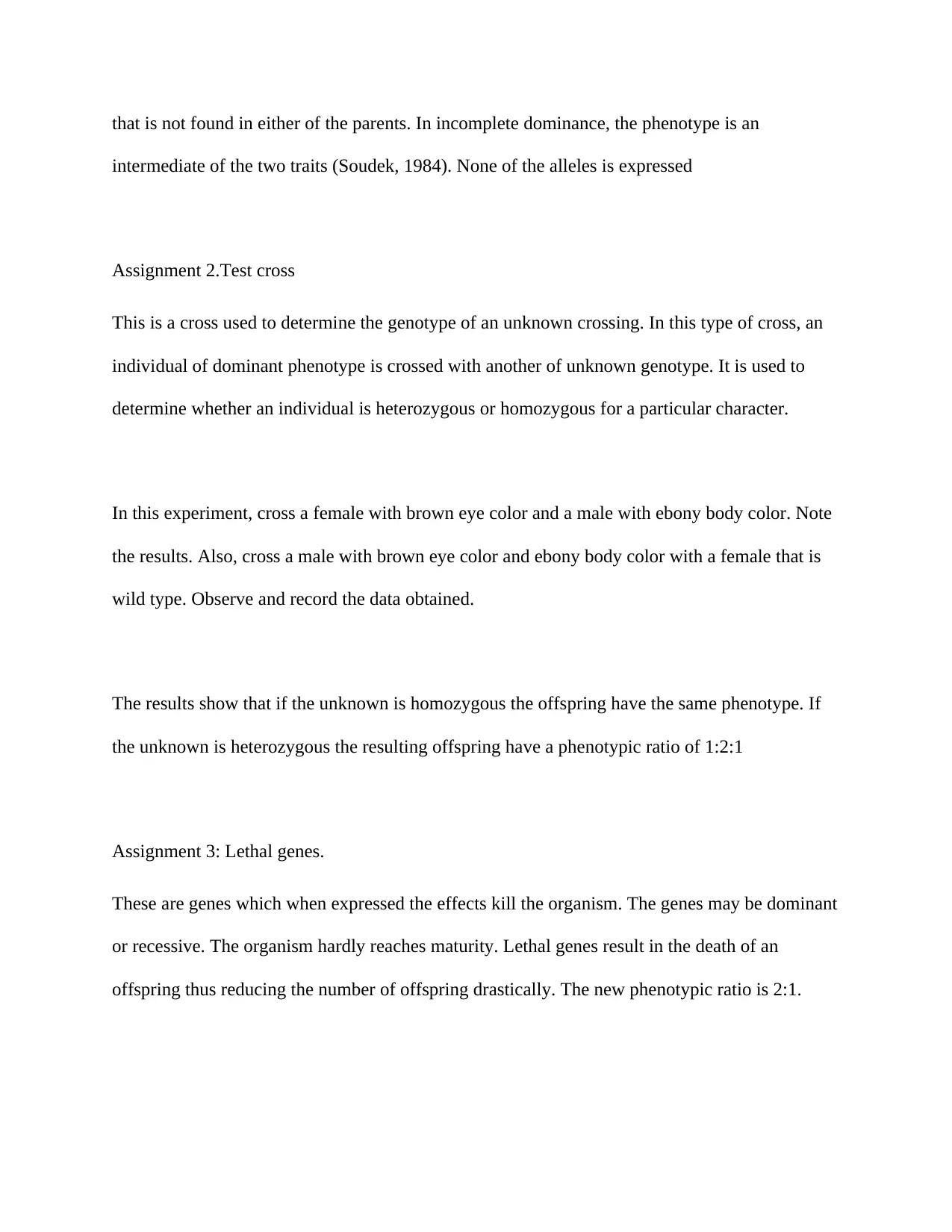
that is not found in either of the parents. In incomplete dominance, the phenotype is an
intermediate of the two traits (Soudek, 1984). None of the alleles is expressed
Assignment 2.Test cross
This is a cross used to determine the genotype of an unknown crossing. In this type of cross, an
individual of dominant phenotype is crossed with another of unknown genotype. It is used to
determine whether an individual is heterozygous or homozygous for a particular character.
In this experiment, cross a female with brown eye color and a male with ebony body color. Note
the results. Also, cross a male with brown eye color and ebony body color with a female that is
wild type. Observe and record the data obtained.
The results show that if the unknown is homozygous the offspring have the same phenotype. If
the unknown is heterozygous the resulting offspring have a phenotypic ratio of 1:2:1
Assignment 3: Lethal genes.
These are genes which when expressed the effects kill the organism. The genes may be dominant
or recessive. The organism hardly reaches maturity. Lethal genes result in the death of an
offspring thus reducing the number of offspring drastically. The new phenotypic ratio is 2:1.
intermediate of the two traits (Soudek, 1984). None of the alleles is expressed
Assignment 2.Test cross
This is a cross used to determine the genotype of an unknown crossing. In this type of cross, an
individual of dominant phenotype is crossed with another of unknown genotype. It is used to
determine whether an individual is heterozygous or homozygous for a particular character.
In this experiment, cross a female with brown eye color and a male with ebony body color. Note
the results. Also, cross a male with brown eye color and ebony body color with a female that is
wild type. Observe and record the data obtained.
The results show that if the unknown is homozygous the offspring have the same phenotype. If
the unknown is heterozygous the resulting offspring have a phenotypic ratio of 1:2:1
Assignment 3: Lethal genes.
These are genes which when expressed the effects kill the organism. The genes may be dominant
or recessive. The organism hardly reaches maturity. Lethal genes result in the death of an
offspring thus reducing the number of offspring drastically. The new phenotypic ratio is 2:1.
⊘ This is a preview!⊘
Do you want full access?
Subscribe today to unlock all pages.

Trusted by 1+ million students worldwide
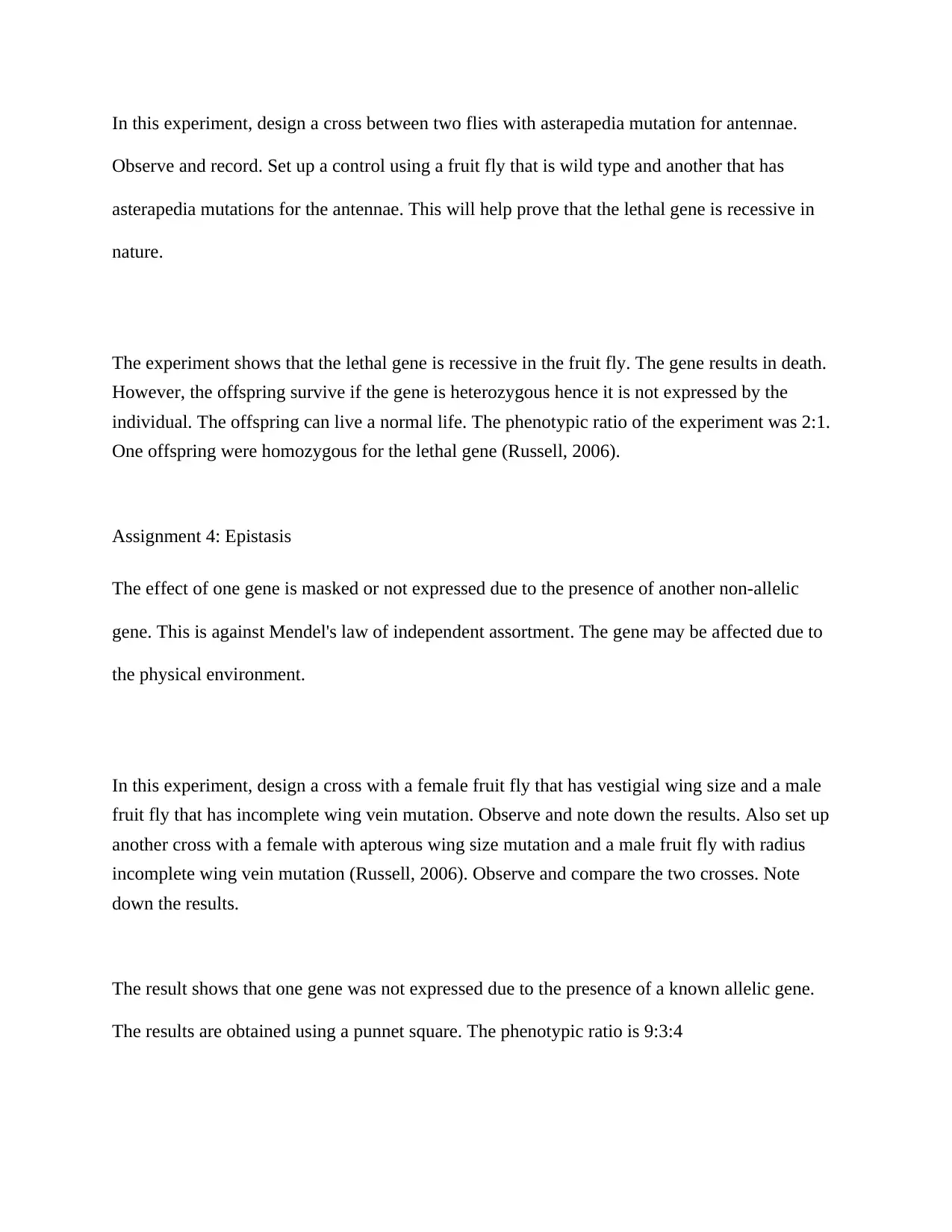
In this experiment, design a cross between two flies with asterapedia mutation for antennae.
Observe and record. Set up a control using a fruit fly that is wild type and another that has
asterapedia mutations for the antennae. This will help prove that the lethal gene is recessive in
nature.
The experiment shows that the lethal gene is recessive in the fruit fly. The gene results in death.
However, the offspring survive if the gene is heterozygous hence it is not expressed by the
individual. The offspring can live a normal life. The phenotypic ratio of the experiment was 2:1.
One offspring were homozygous for the lethal gene (Russell, 2006).
Assignment 4: Epistasis
The effect of one gene is masked or not expressed due to the presence of another non-allelic
gene. This is against Mendel's law of independent assortment. The gene may be affected due to
the physical environment.
In this experiment, design a cross with a female fruit fly that has vestigial wing size and a male
fruit fly that has incomplete wing vein mutation. Observe and note down the results. Also set up
another cross with a female with apterous wing size mutation and a male fruit fly with radius
incomplete wing vein mutation (Russell, 2006). Observe and compare the two crosses. Note
down the results.
The result shows that one gene was not expressed due to the presence of a known allelic gene.
The results are obtained using a punnet square. The phenotypic ratio is 9:3:4
Observe and record. Set up a control using a fruit fly that is wild type and another that has
asterapedia mutations for the antennae. This will help prove that the lethal gene is recessive in
nature.
The experiment shows that the lethal gene is recessive in the fruit fly. The gene results in death.
However, the offspring survive if the gene is heterozygous hence it is not expressed by the
individual. The offspring can live a normal life. The phenotypic ratio of the experiment was 2:1.
One offspring were homozygous for the lethal gene (Russell, 2006).
Assignment 4: Epistasis
The effect of one gene is masked or not expressed due to the presence of another non-allelic
gene. This is against Mendel's law of independent assortment. The gene may be affected due to
the physical environment.
In this experiment, design a cross with a female fruit fly that has vestigial wing size and a male
fruit fly that has incomplete wing vein mutation. Observe and note down the results. Also set up
another cross with a female with apterous wing size mutation and a male fruit fly with radius
incomplete wing vein mutation (Russell, 2006). Observe and compare the two crosses. Note
down the results.
The result shows that one gene was not expressed due to the presence of a known allelic gene.
The results are obtained using a punnet square. The phenotypic ratio is 9:3:4
Paraphrase This Document
Need a fresh take? Get an instant paraphrase of this document with our AI Paraphraser
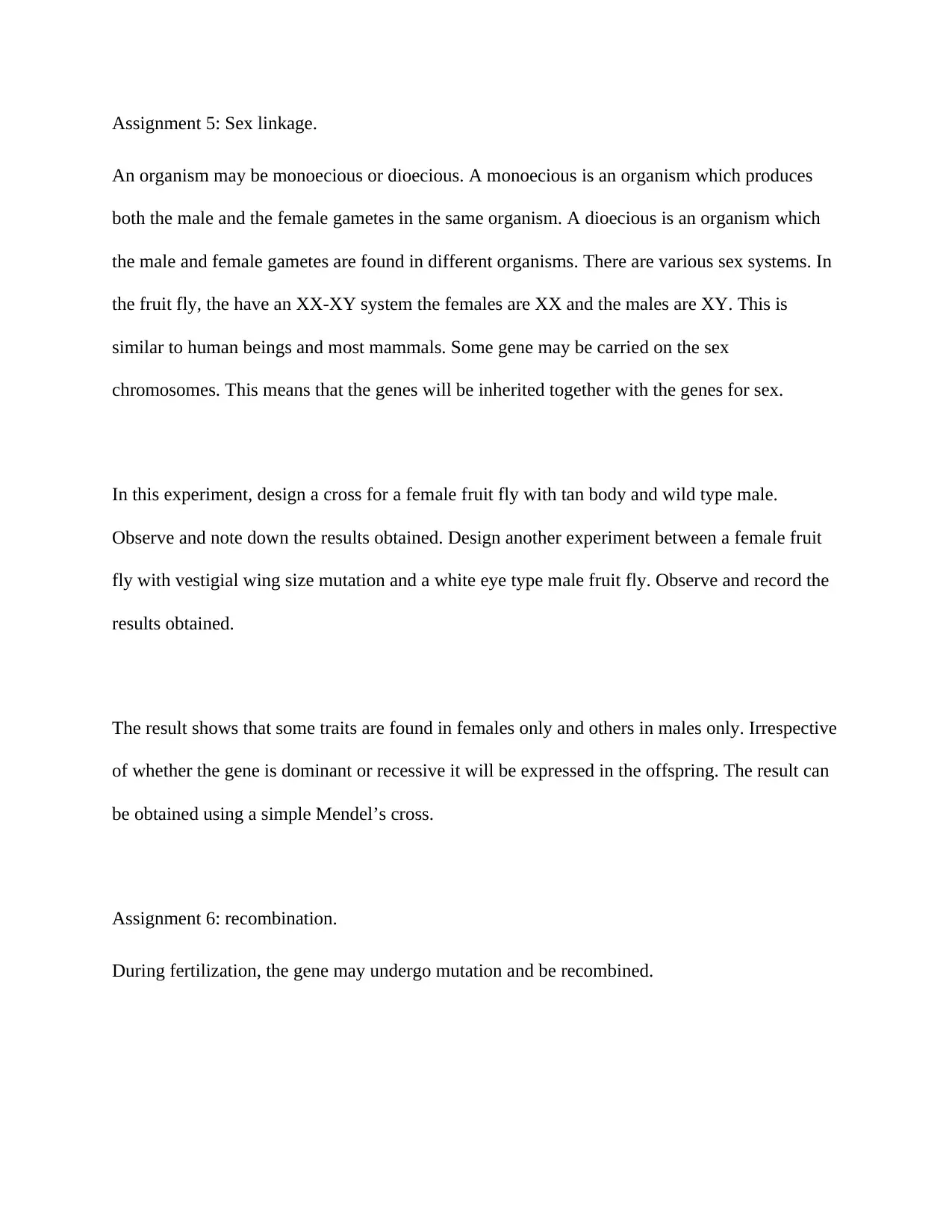
Assignment 5: Sex linkage.
An organism may be monoecious or dioecious. A monoecious is an organism which produces
both the male and the female gametes in the same organism. A dioecious is an organism which
the male and female gametes are found in different organisms. There are various sex systems. In
the fruit fly, the have an XX-XY system the females are XX and the males are XY. This is
similar to human beings and most mammals. Some gene may be carried on the sex
chromosomes. This means that the genes will be inherited together with the genes for sex.
In this experiment, design a cross for a female fruit fly with tan body and wild type male.
Observe and note down the results obtained. Design another experiment between a female fruit
fly with vestigial wing size mutation and a white eye type male fruit fly. Observe and record the
results obtained.
The result shows that some traits are found in females only and others in males only. Irrespective
of whether the gene is dominant or recessive it will be expressed in the offspring. The result can
be obtained using a simple Mendel’s cross.
Assignment 6: recombination.
During fertilization, the gene may undergo mutation and be recombined.
An organism may be monoecious or dioecious. A monoecious is an organism which produces
both the male and the female gametes in the same organism. A dioecious is an organism which
the male and female gametes are found in different organisms. There are various sex systems. In
the fruit fly, the have an XX-XY system the females are XX and the males are XY. This is
similar to human beings and most mammals. Some gene may be carried on the sex
chromosomes. This means that the genes will be inherited together with the genes for sex.
In this experiment, design a cross for a female fruit fly with tan body and wild type male.
Observe and note down the results obtained. Design another experiment between a female fruit
fly with vestigial wing size mutation and a white eye type male fruit fly. Observe and record the
results obtained.
The result shows that some traits are found in females only and others in males only. Irrespective
of whether the gene is dominant or recessive it will be expressed in the offspring. The result can
be obtained using a simple Mendel’s cross.
Assignment 6: recombination.
During fertilization, the gene may undergo mutation and be recombined.
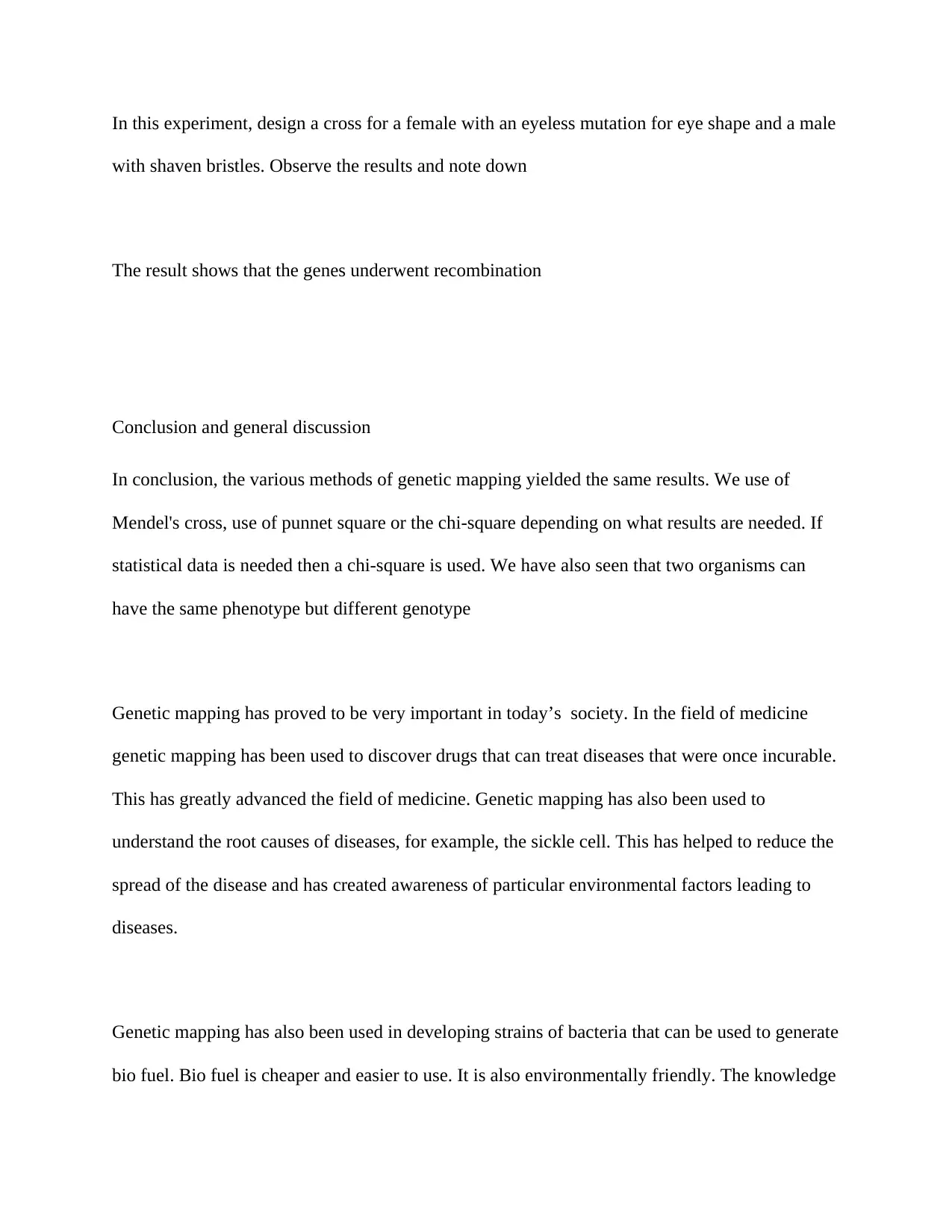
In this experiment, design a cross for a female with an eyeless mutation for eye shape and a male
with shaven bristles. Observe the results and note down
The result shows that the genes underwent recombination
Conclusion and general discussion
In conclusion, the various methods of genetic mapping yielded the same results. We use of
Mendel's cross, use of punnet square or the chi-square depending on what results are needed. If
statistical data is needed then a chi-square is used. We have also seen that two organisms can
have the same phenotype but different genotype
Genetic mapping has proved to be very important in today’s society. In the field of medicine
genetic mapping has been used to discover drugs that can treat diseases that were once incurable.
This has greatly advanced the field of medicine. Genetic mapping has also been used to
understand the root causes of diseases, for example, the sickle cell. This has helped to reduce the
spread of the disease and has created awareness of particular environmental factors leading to
diseases.
Genetic mapping has also been used in developing strains of bacteria that can be used to generate
bio fuel. Bio fuel is cheaper and easier to use. It is also environmentally friendly. The knowledge
with shaven bristles. Observe the results and note down
The result shows that the genes underwent recombination
Conclusion and general discussion
In conclusion, the various methods of genetic mapping yielded the same results. We use of
Mendel's cross, use of punnet square or the chi-square depending on what results are needed. If
statistical data is needed then a chi-square is used. We have also seen that two organisms can
have the same phenotype but different genotype
Genetic mapping has proved to be very important in today’s society. In the field of medicine
genetic mapping has been used to discover drugs that can treat diseases that were once incurable.
This has greatly advanced the field of medicine. Genetic mapping has also been used to
understand the root causes of diseases, for example, the sickle cell. This has helped to reduce the
spread of the disease and has created awareness of particular environmental factors leading to
diseases.
Genetic mapping has also been used in developing strains of bacteria that can be used to generate
bio fuel. Bio fuel is cheaper and easier to use. It is also environmentally friendly. The knowledge
⊘ This is a preview!⊘
Do you want full access?
Subscribe today to unlock all pages.

Trusted by 1+ million students worldwide
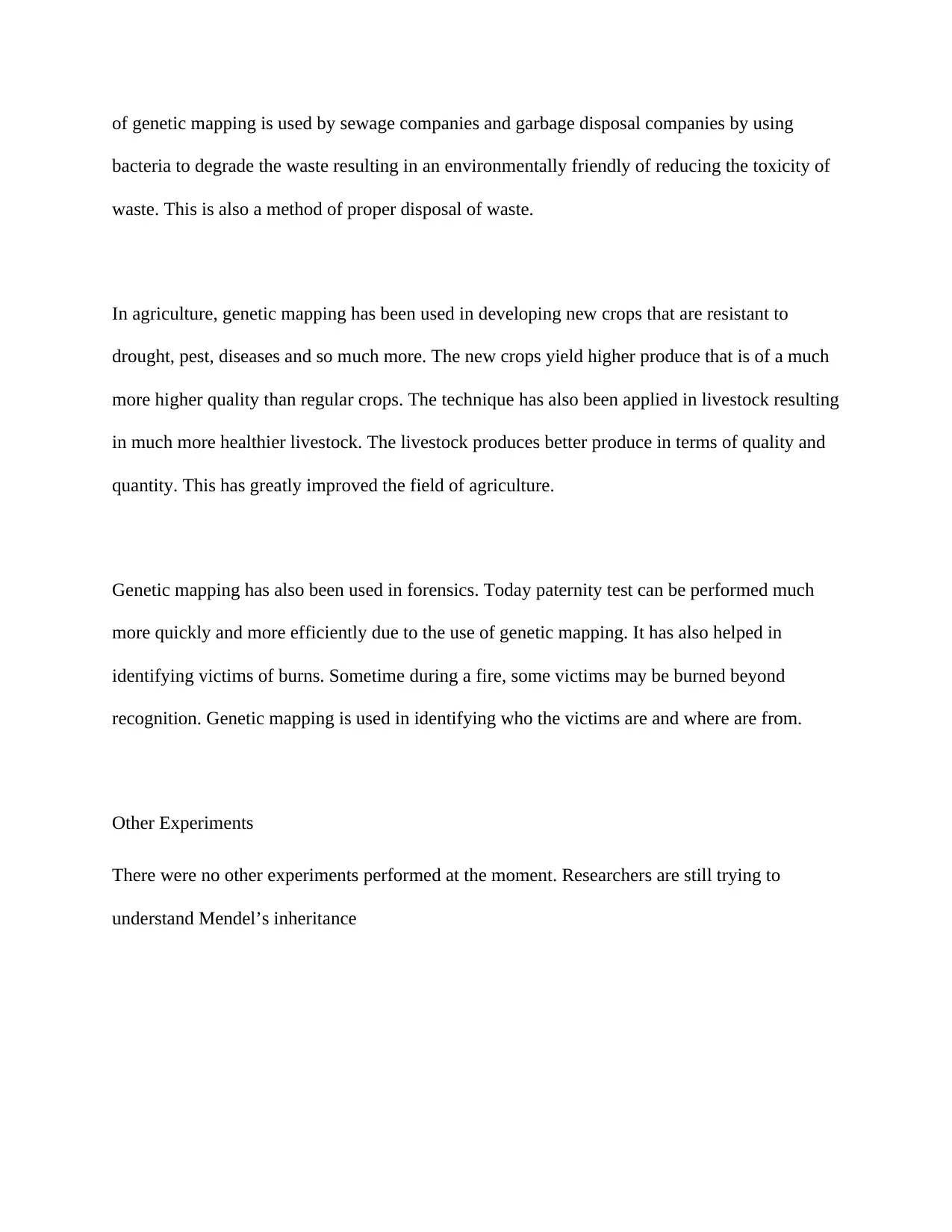
of genetic mapping is used by sewage companies and garbage disposal companies by using
bacteria to degrade the waste resulting in an environmentally friendly of reducing the toxicity of
waste. This is also a method of proper disposal of waste.
In agriculture, genetic mapping has been used in developing new crops that are resistant to
drought, pest, diseases and so much more. The new crops yield higher produce that is of a much
more higher quality than regular crops. The technique has also been applied in livestock resulting
in much more healthier livestock. The livestock produces better produce in terms of quality and
quantity. This has greatly improved the field of agriculture.
Genetic mapping has also been used in forensics. Today paternity test can be performed much
more quickly and more efficiently due to the use of genetic mapping. It has also helped in
identifying victims of burns. Sometime during a fire, some victims may be burned beyond
recognition. Genetic mapping is used in identifying who the victims are and where are from.
Other Experiments
There were no other experiments performed at the moment. Researchers are still trying to
understand Mendel’s inheritance
bacteria to degrade the waste resulting in an environmentally friendly of reducing the toxicity of
waste. This is also a method of proper disposal of waste.
In agriculture, genetic mapping has been used in developing new crops that are resistant to
drought, pest, diseases and so much more. The new crops yield higher produce that is of a much
more higher quality than regular crops. The technique has also been applied in livestock resulting
in much more healthier livestock. The livestock produces better produce in terms of quality and
quantity. This has greatly improved the field of agriculture.
Genetic mapping has also been used in forensics. Today paternity test can be performed much
more quickly and more efficiently due to the use of genetic mapping. It has also helped in
identifying victims of burns. Sometime during a fire, some victims may be burned beyond
recognition. Genetic mapping is used in identifying who the victims are and where are from.
Other Experiments
There were no other experiments performed at the moment. Researchers are still trying to
understand Mendel’s inheritance
Paraphrase This Document
Need a fresh take? Get an instant paraphrase of this document with our AI Paraphraser
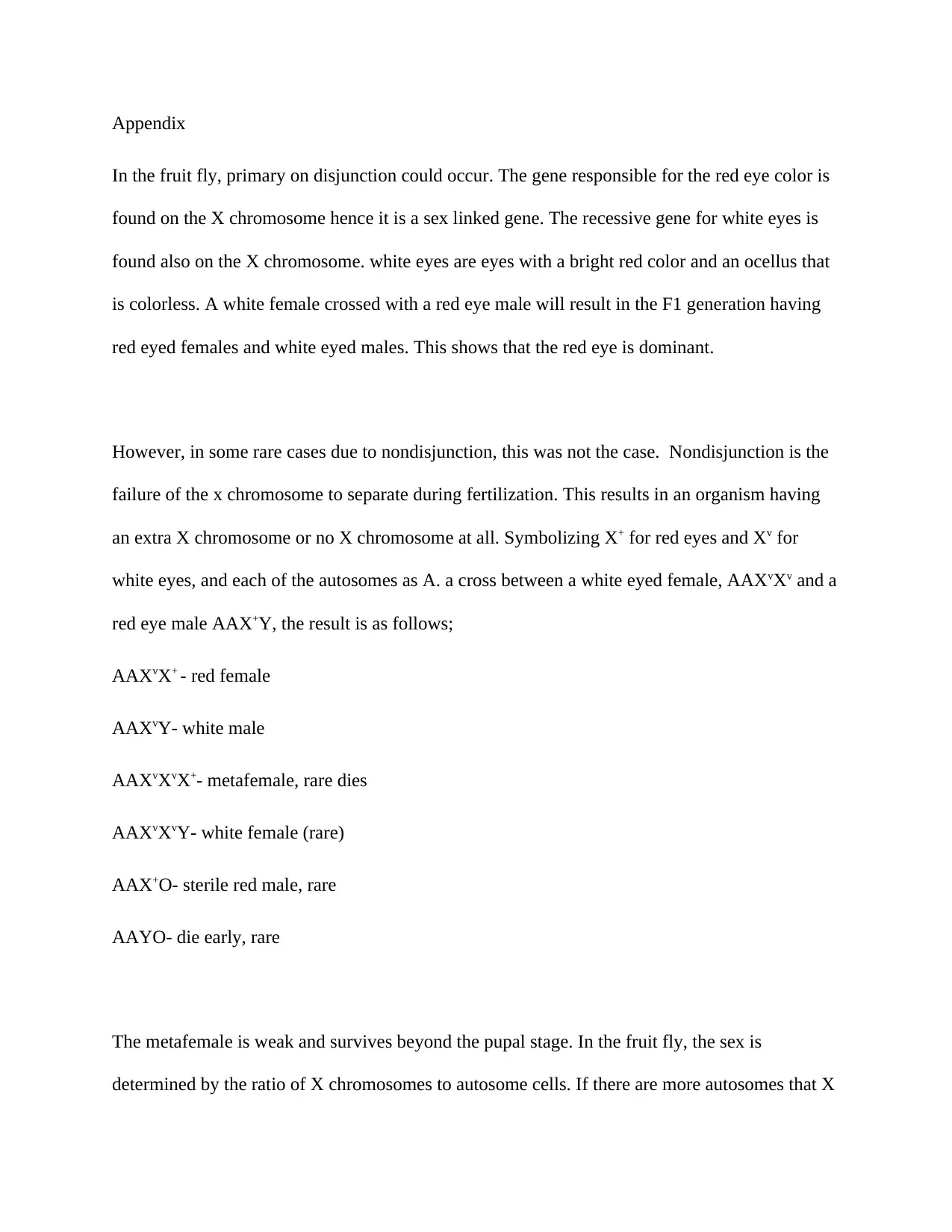
Appendix
In the fruit fly, primary on disjunction could occur. The gene responsible for the red eye color is
found on the X chromosome hence it is a sex linked gene. The recessive gene for white eyes is
found also on the X chromosome. white eyes are eyes with a bright red color and an ocellus that
is colorless. A white female crossed with a red eye male will result in the F1 generation having
red eyed females and white eyed males. This shows that the red eye is dominant.
However, in some rare cases due to nondisjunction, this was not the case. Nondisjunction is the
failure of the x chromosome to separate during fertilization. This results in an organism having
an extra X chromosome or no X chromosome at all. Symbolizing X+ for red eyes and Xv for
white eyes, and each of the autosomes as A. a cross between a white eyed female, AAXvXv and a
red eye male AAX+Y, the result is as follows;
AAXvX+ - red female
AAXvY- white male
AAXvXvX+- metafemale, rare dies
AAXvXvY- white female (rare)
AAX+O- sterile red male, rare
AAYO- die early, rare
The metafemale is weak and survives beyond the pupal stage. In the fruit fly, the sex is
determined by the ratio of X chromosomes to autosome cells. If there are more autosomes that X
In the fruit fly, primary on disjunction could occur. The gene responsible for the red eye color is
found on the X chromosome hence it is a sex linked gene. The recessive gene for white eyes is
found also on the X chromosome. white eyes are eyes with a bright red color and an ocellus that
is colorless. A white female crossed with a red eye male will result in the F1 generation having
red eyed females and white eyed males. This shows that the red eye is dominant.
However, in some rare cases due to nondisjunction, this was not the case. Nondisjunction is the
failure of the x chromosome to separate during fertilization. This results in an organism having
an extra X chromosome or no X chromosome at all. Symbolizing X+ for red eyes and Xv for
white eyes, and each of the autosomes as A. a cross between a white eyed female, AAXvXv and a
red eye male AAX+Y, the result is as follows;
AAXvX+ - red female
AAXvY- white male
AAXvXvX+- metafemale, rare dies
AAXvXvY- white female (rare)
AAX+O- sterile red male, rare
AAYO- die early, rare
The metafemale is weak and survives beyond the pupal stage. In the fruit fly, the sex is
determined by the ratio of X chromosomes to autosome cells. If there are more autosomes that X

chromosomes the individual is male. If the X chromosomes are more or equal to autosomes the
individual is female. The Y chromosomes have no function in gender and it only plays a role in
fertility.
individual is female. The Y chromosomes have no function in gender and it only plays a role in
fertility.
⊘ This is a preview!⊘
Do you want full access?
Subscribe today to unlock all pages.

Trusted by 1+ million students worldwide
1 out of 13
Related Documents
Your All-in-One AI-Powered Toolkit for Academic Success.
+13062052269
info@desklib.com
Available 24*7 on WhatsApp / Email
![[object Object]](/_next/static/media/star-bottom.7253800d.svg)
Unlock your academic potential
Copyright © 2020–2025 A2Z Services. All Rights Reserved. Developed and managed by ZUCOL.





